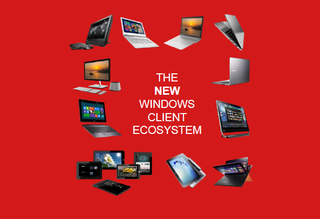AMD Temash chipset to lower cost of Windows tablets
iPad-equivilant pricing on the way, says semi-conductor firm.

AMD claims its next-generation of chips will help OEMs decrease the price point of Windows tablets and provide high-performance graphical capabilities within laptops.
The semiconductor vendor has confirmed details for its forthcoming Temash, Kabini and Richland chipsets. AMD hopes this generation will help it battle against firms such as Qualcomm, Nvidia and Intel who are all making significant pushes into the mobile market.
Tablets
The Temash SoC is designed to be utilised primarily in tablets, but will also be available for use in small-form factor clamshells.
AMD is confident the low power draw of the Temash chips (3.9 Watts in some cases) will help OEMs lower the price of tablets.
"Windows [8] couldn't hit the price of the iPad (399), we want to make sure with Temash we can get OEMs and customers at the price point," Sasa Marinkovic, head of technology marketing at AMD told journalists at a pre-brief.
AMD will release dual-core and quad-core varieties. The entry-level A4 Temash chipset will feature up to eight hours of battery life, and have AMD's proprietary video streaming, Radeon HD graphics and video stabilisation technologies built in.
Get the ITPro. daily newsletter
Receive our latest news, industry updates, featured resources and more. Sign up today to receive our FREE report on AI cyber crime & security - newly updated for 2024.
The more powerful A6 family will have the same base-line features and also ship with Gesture Control, Face Login and Screen Mirroring capabilities as standard.
Clamshell devices will also include AMD's turbo dock technology. When a user plugs a display into the keyboard, the firm claims performance will be automatically ramped by up to 40 per cent.
The A4 and A6 Temash chips are expected to have better performance than Intel's Atom chips, but will fall short of the competing Core i3 range.
Marinkovic claimed that Temash will be highly competitive - and supports a variety of technologies that competing products do not.
"You'll see we have a whole bunch of features that CloverTrail cannot do. So much so that we've seen Intel pulling in their schedule for next-gen products to compete with [Temash]," he said.
These include support for VGA, DirectX 11, up to 8GB memory, USB 2 and 3 ports as well as application acceleration.
Laptops
Despite OEMs such as Dell seeing a 79 per cent slide in profits during the last quarter, AMD believes there is a market out there for traditional devices.
"When I look around the room, everyone still has a laptop with them. It is the primary device for work/productivity," Marinkovic continued.
"Our focus is going to be on new devices all-in-ones, clamshells [and] hybrid tablets."
AMD will release two chipset dedicated to laptops the entry-level Kabini and high-end Richland family.
Kabini will compete with Intel's Pentium and Core i3 ranges, and offer nine hours of battery life for web browsing and six hours for 1080p HD video playback.
AMD is touting high performance and graphical gains over the previous generation. The firm says it is 25 per cent more efficient than its predecessor and graphics performance per watt is 133 per cent better.
Richland will go head-to-head with Intel's Core i5 range, and provide around 7.5 hours of web browsing, according to Marinkovic.
He claimed overall performance of the Richland system is up 20 per cent on the previous generation.




